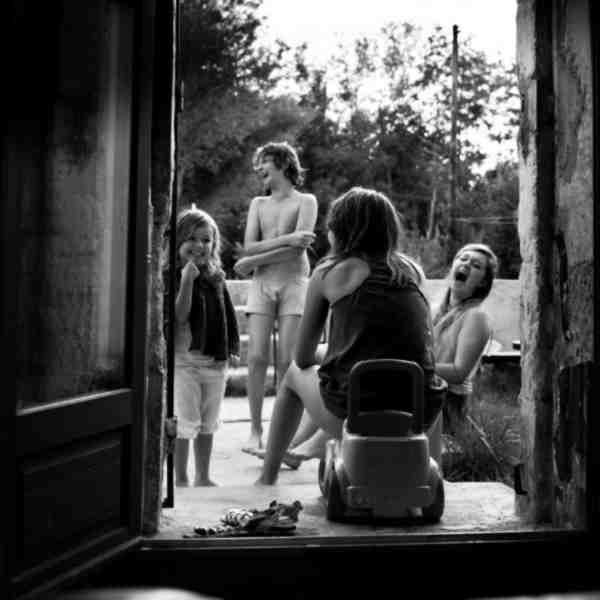Over the last several years I have been periodically checking in to Alain Laboile‘s web site to enjoy pictures of his family. They live in a secluded rural part of France and Alain’s photographic documentation of the children’s exploits are positively delightful. No small part of the reason is that Laboile is a discerning photographer with an artist’s eye. He is in fact a sculptor and graphic artist and his family album documenting his family is well worth your time. And money (he has a book or two for sale — see above for the URL to his website).
The above picture is of part of his family laughing about something. No text is provided with these family pictures so it is not possible to know what they are laughing about. But they do laugh a lot and the children are forever probing and testing their environment as they grow and learn in a natural and uninhibited way lost long ago by most of us in the Western world.
The thing about this picture of their laughter is the way they heartily laugh without reservation. It seems to me we Americans used to laugh a lot. Not so much anymore, though, I’m sorry to say.

This is a picture taken many years ago of some dear friends who lived in Luxembourg at the time. (They are Dutch, originally from The Hague — Den Haag, or Sravenhaga, to native Nederlanders.) I meant to get them to smile for the picture I was about to take but I obviously overdid it. Whatever I said cracked them up and, being the amateur that I was, I went ahead and snapped the picture anyway.
I didn’t care much for this picture originally because convention had it that pictures of people laughing bigly were not good pictures. You know, mouth wide open, eyes half shut, enjoying a great good guffaw.
But over the years I have returned more and more often to this picture because it truly captured the nature of these friends. They laughed often and large. They were not self-conscious about their laughter and it was never forced. They laughed when they felt like it and didn’t when they did not, yet managed to never be insensitive or rude.
It seems to me we Americans used to be at least a little bit that way. When I was growing up around animals and barns and windmills and other hayseeds in the 1940s and 1950s (I was born in 1939, if you must know) laughter was important and not a day went by that you would not hear someone laugh hugely. Someone would bust a gut, as we used to say.
Today unfortunately there is a pall upon the land. In my people watching I hardly ever observe anything more than a courteous (or often nervous, it seems) chuckle. There is one glaring exception to this I should point out, often in situation where alcohol is available. You can’t help noticing when someone in the near vicinity laughs loudly and obnoxiously. Over and over again. Dominating the surrounding sound space with non-stop forced hilarity. That kind of hysterical noise making just doesn’t qualify as honest laughter. Alcohol fueled (possibly) desperation laughter only makes more obvious the generalized absence of good humor in us stressed-out Americans.
I’ll not launch into speculation about why so many of us are maxed out on stress. Everyone has his own opinions about what is going on today and airing those opinions often ends badly. Suffice it to say things are not going well for us today.
People do still laugh, of course. Sometimes uproariously. But my point is that the big laugh has become rarer, more the exception rather. Big laughter is not expected frequently. Beyond any socio-psychological analysis of what’s wrong with us, what does diminished laughter mean as a cause, rather than an effect? That is, rather than the reasons for less laughter, what does laughing less — or for some people, it would seem, not at all — do to us?
Theories of laughter abound, none of them totally convincing or satisfactory. I’ve read most of them and I still can’t give you even a vague precis as to what laughter is. I once in my dim ancient past had a setup in my lab for research that required spoken English language played backwards. This required a not-insignificant technological setup. Or at least it did back then.
Laughter was not on our research agenda but we did analyze a few samples of laughter just out of curiosity. We noted some of the stereotypic ingredients of laughter like laugh‐note structure and duration, internote intervals, crescendos and decrescendos — boring stuff like that. Just for the heck of it we played recorded laughter backwards to see what it sounded like.
We were curious about reversed laughter because ordinary spoken language, when played in reverse, sounds nothing like ordinary speech. Backward speech creates sounds that are impossible to make with the human mouth and not likely to be mistaken for any human language.
Interestingly, we noted that laughter played backward sounds pretty much like ordinary laughter. Whether it was one person’s laughter or the recorded laughter of several people laughing at the same time, it all sounded like you would expect laughter to sound. That may not surprise you be we found it remarkable. Why should laughter be so different from spoken language? Alas, it was a question we never got around to addressing.
We were just too busy at the time to spend much time on laughter. I wish we could have but we were steeped in studies associated with the production, perception, and evolution of human auditory signals of which speech is a special case. The particular dynamics of human laughter clearly demarcate a domain of neuroscientific inquiry; I thought it would be (and others have shown this to be correct) fruitful to analyze the neurobehavioral mechanisms involved in laugh detection and generation. I am eagerly following the ongoing research in this area but so far there is not much to interest anyone outside of a laboratory setting.
Laughter is a reflex located in the reticular system of the hindbrain. The whole enterprise of human laughter is quite complex. Preceded by smiling, even in the womb, laughter appears very early in life, sometimes within just a few days of birth. Each of us has his own characteristic laugh which is stable throughout our lives.
It is commonly assumed that laughter and speech differentiate us from the rest of the animal kingdom. Frankly I’m not as sanguine about that as I once allowed myself to be. With age comes wisdom and a greater awareness of ignorance. Consider for instance how much more ignorant we are today than were the people of, say, Copernicus’ time. That’s because we are much more aware of how much we don’t know than was Nick (1473-1543 AD) and his contemporaries back in the 15th century. He did not know it was even possible to plot the path from a launch pad on Earth to a landing site on the moon, and back again. I do know that it is possible, and I also know that I do not know how to do it. Hence I am more ignorant than anyone living in Copernicus’ time.
That having been said, and perhaps apropos of nothing, I am no longer as confident as I once was that other animals do not have language skills the way we humans do. And I have not since my childhood Sunday school days thought that animals do not laugh. I’ve always suspected that that hunh-hunh-hunh from a horse that had just dumped me on the ground by “inadvertently” stumbling was a chuckle. The horse’s version of heh heh heh. And the horse’s highly mobile ears would usually twitch just a little as they chuckled at me lying on the ground.
By the way, you know that way horses have of curling their upper lip and opening their mouth? They look like they are laughing. They are not. They are getting ready to bite the crap out of you. Run.
Rats giggle when tickled. They seek out the handler’s hand that is doing the tickling — “Do it again, Daddy, do it again!” Then they struggle to escape the tickling as they issue a subsonic titter. Sound like any kids you know (except the subsonic part is usually supersonic with kids of the human persuasion)?
Then there was Omar. Omar was a pet parakeet I once had whom I refused to keep caged up. He did had a cage which was his place of privacy where he ate (mostly) and slept at night. He insisted that his cage be covered at night so he could sleep undisturbed and he became quite vocal in the morning when it was time to remove the cover so he could get out and say good morning. The door to his cage was always open.
Omar loved to throw things off the coffee table. I had a handful of small cotton swabs (Q-Tips is one brand name) which I would scatter on the table and Omar would grab one in his beak, walk over to the edge of the table, and drop it to the floor. Then make a sound that could only be taken as a parakeet’s laugh as he looked down at his handiwork. He would do this repeatedly until all the swabs were on the floor, sufficiently laughed at.
This was play for Omar. Most animals, it appears, like to play. Everyone has played with dogs and cats, but who would have thought birds like to play. In my experience the only animals I’ve been around but never seen play were cattle. Calves play but seem to give it up when they get older. Like some people I know.
Laughter is closely related to play. I don’t recall ever hearing noises from playing calves or colts, but who knows? If rats can make laughing sounds undetectable by human ears, maybe other animals can too.
Laughter is a unique medium of communication. All human societies speak their own language but the sounds of their laughter are universal. Most people laugh at least sometimes but there are always some who never laugh. I’ve known a few of those and to a man I did not like them. I can’t recall ever knowing a woman who never laughed. Oh, wait, I take that back. Many years ago there was an undergraduate in Colorado who took a couple of my classes. She would not even smile because, she said, she did not want to cause wrinkles. She was a professional model. That explains a lot right there.
Laughter has a mood elevating and relaxing effect, but only when it is of the right kind. Cynical, cruel or derisive laughter does not appear to have any positive effects. But what I’ll call here clean or healthy laughter does — muscles are activated; heart rate is increased; respiration is amplified, with a concomitant increase in oxygen exchange. All of these are antithetical to stress so laughter is a great method of stress management.
The healing power of humor has been a serious subject ever since 1964 when a guy named Norman Cousins — at the time a well known American political journalist and author — used humor to cure himself, by his claim, of ankylosing spondylitis. To do this he watched comedy movies and claimed that watching (and laughing) for ten minutes would give him two hours of pain free sleep.
We know there is a profound relationship between stress, which we can think of as negative emotions, and disease and illness. Somewhere between 70 and 90 percent of disease and illness is strongly associated with stress. Cousins made a strong argument, based on his own experience and his considerable reading of the extant research literature, that if negative thoughts can have negative physiological repercussions, then positive thoughts should have the potential to produce positive effects throughout the body. This kind of thinking which was widely popular at the time led to the development of a new research discipline called psychoneuroimmunology. That is, the study of the mind-body relationship.

By the way, please note that having positive thoughts or even thinking positively does not mean the same as Positive Thinking, the cultist belief in a magical elixir somehow conjured up by mere belief. The cult of Positive Thinking is essentially a religious devotion to an imagined power of belief. If you can make yourself believe it, it will come true. As I have written elsewhere and at length, Positive Thinking does more harm than good. Sometimes this is difficult for people to understand because of all the nonsense proliferated by hucksters like Napoleon Hill and religious crackpot preacher Norman Vincent Peale (also known as the Grand Imperial Chaplain of the Shriners). But I digress.
It cannot be said that psychoneuroimmunology has made a lot of progress. I submit that that is because it is a) a really dumb name and b) it was immediately hijacked by the medical profession. Now, I don’t have a lot against the American medical profession (take that with a grain of NaCl) but it is well known that it is difficult to make headway in any area — research or applied — that does not hold the promise of outrageously profitable new drugs for the pharmaceutical industry or expensive gadgets for the biomechanical manufacturers to make and sell.
But let’s get back to laughter and how we don’t do as much of it as we used to. Laughing, that is. Laughter or a jolly demeanor go together, which also goes with positive thinking. Maybe we have done to much laughing and feeling positive, or forcing a positive outlook. That might be one of the reasons we are in such a pickle today. If you force yourself to look on the positive side all the time you miss a lot. You are less likely to see things, or people, creeping up on you. Things that are not in your best interest and tend to waylay you when they catch you by surprise.
For that matter, someone who is really into seeing only the bright side probably would not waste time and money on like, say, insurance. We all know how that can end up. No, a healthy pessimism is in fact the basis of the scientific method as well as being at the root of any analysis meant to be meaningful and useful.
All-out pessimism is not called for and is actually not a good thing. What is needed is a form of balanced, objective pessimism in order to form realistic expectations and conduct a sober evaluation before taking action. This facilitates a thinking-through of all the negative possibilities in order to avoid them.
Objective pessimism can be the precursor to objective optimism. That is, wax negative and play the devil’s advocate as preparation for something you intend to do. Be tough. Be rigorous. Get it all out there where you can deal the potential negatives. Once you have done that thoroughly, put aside the negative attitude and be positive.
Not blindly positive — you should always be alert and ready to get back into objective pessimism mode. This way you are less likely to turn a negative attitude into a self-fulfilling prophecy.







